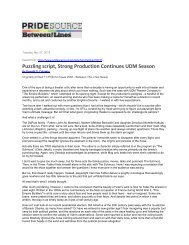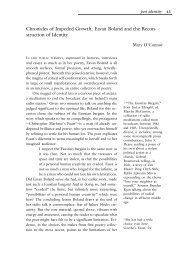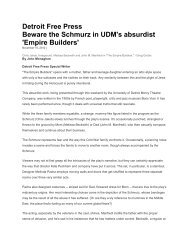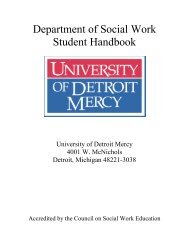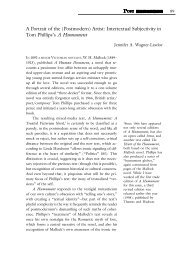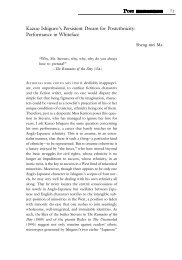Conquest, Conversion, and the Hybrid Self in Cabeza de Vaca's ...
Conquest, Conversion, and the Hybrid Self in Cabeza de Vaca's ...
Conquest, Conversion, and the Hybrid Self in Cabeza de Vaca's ...
You also want an ePaper? Increase the reach of your titles
YUMPU automatically turns print PDFs into web optimized ePapers that Google loves.
132 POST OST IDENTITY<br />
IDENTITY<br />
his waver<strong>in</strong>g between discoverer <strong>and</strong> ethnographer to <strong>the</strong><br />
lim<strong>in</strong>al moment <strong>in</strong> Victor Turner’s <strong>de</strong>scription of <strong>the</strong> tripartite<br />
ritual process. As Turner expla<strong>in</strong>s, after <strong>the</strong> <strong>in</strong>itiant<br />
is separated from <strong>the</strong> group or some social system, but<br />
before he or she is re<strong>in</strong>corporated <strong>in</strong>to <strong>the</strong> culture, <strong>the</strong><br />
neophyte passes through a “lim<strong>in</strong>al” phase, a moment of<br />
limbo, when <strong>the</strong> “self is split up <strong>the</strong> middle,” becomes<br />
both “subject <strong>and</strong> object, someth<strong>in</strong>g that one both is <strong>and</strong><br />
that one sees <strong>and</strong>, fur<strong>the</strong>rmore, acts upon as though it<br />
were ano<strong>the</strong>r.” In <strong>the</strong> lim<strong>in</strong>al phase, ambivalence results<br />
from <strong>the</strong> <strong>de</strong>sire to act upon “<strong>the</strong> self-ma<strong>de</strong>-o<strong>the</strong>r <strong>in</strong> such a<br />
way as to transform it” (Turner 1969, 94–5; 1987, 25).<br />
Dur<strong>in</strong>g <strong>the</strong> lim<strong>in</strong>al phase, neophytes un<strong>de</strong>rgo a change <strong>in</strong><br />
status: as Turner expla<strong>in</strong>s, “<strong>the</strong>y may be disguised as monsters,<br />
wear only a strip of cloth<strong>in</strong>g, or even go naked, to<br />
<strong>de</strong>monstrate that as lim<strong>in</strong>al be<strong>in</strong>gs <strong>the</strong>y have no status,<br />
property, <strong>in</strong>signia” or anyth<strong>in</strong>g to <strong>in</strong>dicate “rank or role”<br />
or “position <strong>in</strong> a k<strong>in</strong>ship system” (Turner 1969, 95).<br />
Although his lim<strong>in</strong>ality is not <strong>the</strong> result of will<strong>in</strong>g participation<br />
<strong>in</strong> a ritual, <strong>Cabeza</strong> <strong>de</strong> Vaca’s transformation <strong>in</strong>to<br />
an ethnographer occurs dur<strong>in</strong>g an <strong>in</strong><strong>de</strong>term<strong>in</strong>ate moment<br />
strik<strong>in</strong>gly similar to <strong>the</strong> lim<strong>in</strong>al phase. Through his various<br />
excursions through <strong>the</strong> <strong>in</strong>terior of America, he constantly<br />
rem<strong>in</strong>ds his rea<strong>de</strong>rs that he had to live “without clo<strong>the</strong>s”<br />
among <strong>the</strong> natives. No longer does he have his status as<br />
colonizer, or even as a merchant or shaman; he becomes<br />
an object as much as he is a subject. In fact, <strong>the</strong> natives<br />
“o<strong>the</strong>r” him; he is frequently “looked at” by <strong>the</strong> males,<br />
who at times, send “<strong>the</strong>ir women <strong>and</strong> children to look” at<br />
him, who even return <strong>and</strong> repeat <strong>the</strong>ir visits “afterwards<br />
on o<strong>the</strong>r days” (67). In this ambiguous middle ground,<br />
<strong>Cabeza</strong> <strong>de</strong> Vaca can no longer be certa<strong>in</strong> who is “civilized”<br />
<strong>and</strong> who is “savage.” He expla<strong>in</strong>s at one po<strong>in</strong>t that “Five<br />
Christians, of a mess on <strong>the</strong> coast, came to such extremity<br />
that <strong>the</strong>y ate <strong>the</strong>ir <strong>de</strong>ad; <strong>the</strong> body of <strong>the</strong> last one only was<br />
found unconsumed” (74). <strong>Cabeza</strong> <strong>de</strong> Vaca notes that this<br />
event “produced great commotion among <strong>the</strong> Indians,<br />
giv<strong>in</strong>g rise to so much censure that had <strong>the</strong>y known it <strong>in</strong><br />
season to have done so, doubtless <strong>the</strong>y would have <strong>de</strong>stroyed<br />
any survivor, <strong>and</strong> we should have found ourselves<br />
<strong>in</strong> <strong>the</strong> utmost perplexity” (74). But he is not agitated: he<br />
Alan J. Silva




